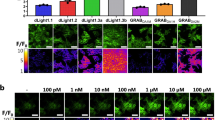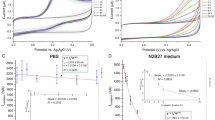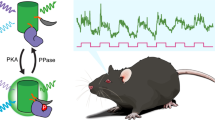Abstract
This protocol represents a novel enzyme-luminescence method to detect dopamine sensitively and rapidly with high temporal resolution. In principle, dopamine is first oxidized with tyramine oxidase to produce H2O2, and then the produced H2O2 reacts with luminol to generate chemiluminescence in the presence of horseradish peroxidase (POD). We applied this method successfully to perform real-time monitoring of dopamine release from PC12 cells using a luminescence plate reader upon stimulation with several drugs (e.g., acetylcholine, bradykinin). The results indicated that the dopamine release from PC12 cells was modulated by these drugs in a way similar to that found by using several conventional analytical techniques, such as HPLC-electrochemical detector (ECD). Unlike other assays, this assay technique is simple, rapid, highly sensitive and thus useful for assessment of effects of drugs on the nervous system. The dopamine release assay takes only ≤1 h once reagent setup and culture plates' preparation are finished.
This is a preview of subscription content, access via your institution
Access options
Subscribe to this journal
Receive 12 print issues and online access
$259.00 per year
only $21.58 per issue
Buy this article
- Purchase on Springer Link
- Instant access to full article PDF
Prices may be subject to local taxes which are calculated during checkout




Similar content being viewed by others
References
Hu, G., Duffy, P., Swanson, C., Ghasemzadeh, M.B. & Kalivas, P.W. The regulation of dopamine transmission by metabotropic glutamate receptors. J. Pharmacol. Exp. Ther. 289, 412–416 (1999).
Cheng, F.C. et al. Determination of catecholamines in pheochromocytoma cell (PC12) culture medium by microdialysis-microbore liquid chromatography. J. Chromatogr. A 870, 405–411 (2000).
Migheli, R. et al. Novel integrated microdialysis-amperometric system for in vitro detection of dopamine secreted from PC12 cells: design, construction and validation. Anal. Biochem. 380, 323–330 (2008).
Yeh, W.-L., Kuo, Y.-R. & Cheng, S.-H. Voltammetry and flow-injection amperometry for indirect determination of dopamine. Electrochem. Comm. 10, 66–70 (2008).
Bezerra, V.S., de Lima Filho, J.L., Montenegro, M.C., Araújo, A.N. & da Silva, V.L. Flow-injection amperometric determination of dopamine in pharmaceuticals using a polyphenol oxidase biosensor obtained from soursop pulp. J. Pharm. Biomed. Anal. 33, 1025–1031 (2003).
Bustos, E.B. et al. Glassy carbon electrodes modified with composites of starburst-PAMAM dendrimers containing metal nanoparticles for amperometric detection of dopamine in urine. Talanta 72, 1586–1592 (2007).
Bruns, D. Detection of transmitter release with carbon fiber electrodes. Methods 33, 312–321 (2004).
Xiang-Qin, L., Guang-Feng, K. & Ying, C. A nafion and choline bi-layer modified carbon fiber electrode for in-vivo detection of dopamine in mouse cerebrum. Chinese J. Anal. Chem. 36, 157–161 (2008).
Suaud-Chagny, M.-F. In vivo monitoring of dopamine overflow in the central nervous system by amperometric techniques combined with carbon fiber electrodes. Methods 33, 322–329 (2004).
Kumar, G.K. et al. Release of dopamine and norepinephrine by hypoxia from PC-12 cells. Am. J. Physiol. Cell Physiol. 274, 1592–1600 (1998).
Cui, H.-F. et al. In situ temporal detection of dopamine exocytosis from l-dopa-incubated MN9D cells using microelectrode array-integrated biochip. Sens. Act. B 115, 634–641 (2006).
Sirén, H. & Karjalainen, U. Study of catecholamines in patient urine samples by capillary electrophoresis. J. Chromatogr. A 853, 527–533 (1999).
Peterson, Z.D., Collins, D.C., Bowerbank, C.R., Lee, M.L. & Graves, S.W. Determination of catecholamines and metanephrines in urine by capillary electrophoresis–electrospray ionization–time-of-flight mass spectrometry. J. Chromatogr. B 776, 221–229 (2002).
Zhang, L., Qv, S., Wang, Z. & Cheng, J. Determination of dopamine in single rat pheochromocytoma cell by capillary electrophoresis with amperometric detection. J. Chromatogr. B 792, 381–385 (2003).
Schöning, M.J. et al. Amperometric PDMS/glass capillary electrophoresis-based biosensor microchip for catechol and dopamine detection. Sens. Act. B 108, 688–694 (2005).
Wang, C.Q., Wang, H. & Liu, Y.M. Capillary electrophoresis with direct chemiluminescence detection for the analysis of catecholamines in human urine. Chinese Chem. Lett. 18, 452–454 (2007).
Israël, M. & Tomasi, M. A chemiluminescent catecholamine assay: its application for monitoring adrenergic transmitter release. J. Neurosci. Methods 91, 101–107 (1999).
Marquette, C.A. & Blum, L.J. Application of the luminol chemiluminescent reaction in analytical chemistry. Anal. Bioanal. Chem. 385, 546–554 (2006).
Shinohara, H. & Wang, F. Enzyme-catalyzed luminescence detection of catecholamine released from nerve model cells. Presented at the International Chemical Congress of Pacific Basin Societies (PACIFICHEM) (Hawaii, December 2005).
Shinohara, H. & Wang, F. Real-time observation of dopamine release from nerve model cells. Presented at the 11th International Meeting on Chemical Sensors (IMCS11) (Brescia, Italy, July 2006).
Shinohara, H. & Wang, F. Real-time detection of dopamine release from a nerve model cells by an enzyme-catalyzed luminescence method and its application to drug assessment. Anal. Sci. 23, 81–84 (2007).
Virgilio, F.D., Milani, D., Leon, A., Meldolesi, J. & Pozzan, T. Voltage-dependent activation and inactivation of calcium channels in PC12 cells. Correlation with neurotransmitter release. J. Biol. Chem. 262, 9189–9195 (1987).
Ritchie, A.K. Catecholamine secretion in a rat pheochromocytoma cell line: two pathways for calcium entry. J. Physiol. 286, 541–561 (1979).
Douglas, W.W., Kanno, T. & Sampson, S.R. Effects of acetylcholine and other medullary secretogogues and antagonist on the membrane potential of adrenal chromaffin cells: an analysis employing techniques of tissue culture. J. Physiol. 188, 107–120 (1967).
Douglas, W.W., Kanno, T. & Sampson, S.R. Influence of the ionic environment on the membrane potential of adrenal chromaffin cells and on the depolarizing effect of acetylcholine. J. Physiol. 191, 107–121 (1967).
Brandt, B.L., Hagiwara, S., Kidokoro, Y. & Miyazaki, S. Action potentials in the rat chromaffin cell and effects of acetylcholine. J. Physiol. 263, 417–439 (1976).
Wachman, E.S., Poage, R.E., Stiles, J.R., Farkas, D.L. & Meriney, S.D. Spatial distribution of calcium entry evoked by single action potentials within the presynaptic active zone. J. Neurosci. 24, 2877–2885 (2004).
Appell, K.C. & Barefoot, D.S. Neurotransmitter release from bradykinin-stimulated PC12 cells. J. Biochem. 263, 11–18 (1989).
van Calker, D., Assmann, K. & Greil, W. Stimulation by bradykinin, angiotensin II, and carbachol of the accumulation of inositol phosphates in PC-12 pheochromocytoma cells: differential effects of lithium ions on inositol mono-and polyphosphates. J. Neurochem. 49, 1379–1385 (1987).
Acknowledgements
This work was supported by a grant of Toyama-Medical Bio Cluster project, MEXT in Japan.
Author information
Authors and Affiliations
Corresponding authors
Rights and permissions
About this article
Cite this article
Shinohara, H., Wang, F. & Hossain, S. A convenient, high-throughput method for enzyme-luminescence detection of dopamine released from PC12 cells. Nat Protoc 3, 1639–1644 (2008). https://doi.org/10.1038/nprot.2008.158
Published:
Issue Date:
DOI: https://doi.org/10.1038/nprot.2008.158
This article is cited by
Comments
By submitting a comment you agree to abide by our Terms and Community Guidelines. If you find something abusive or that does not comply with our terms or guidelines please flag it as inappropriate.



